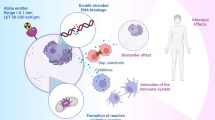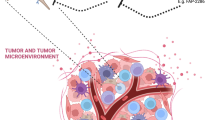The cytotoxic effectsin vivo of 4′-(9-acridinylamino) methanesulfon-m-anisidide (AMSA), radiation or both modalities in combination on murine fibrosarcoma (FSa) cells grown as pulmonary tumors were determined. Fourteen days following the i.v. injection of viable FSa cells, recipient mice developed between 100 and 150 visible pulmonary nodules. At that time, tumor-bearing animals were exposed to either single or combined modality treatments, as well as single and fractionated dose regimens. Animals were sacrificed 1 hour after the last treatment. Tumor nodules were excised, made into a single cell suspension and separated on the basis of cell size by centrifugal elutriation. Flow microfluorometry (FMF) was used to determine the cell-cycle parameters and the relative synchrony of the separated populations, as well as the percentage contamination by normal diploid cells in each of the tumor cell populations. Known numbers of viable cells from each elutriator fraction were injected into recipient mice to determine their colony-forming efficiency (CFE). Surviving fractions were determined by comparing the CFEs of treated FSa cells from each of the separated elutriator fractions with those of appropriate untreated controls. Following a single i.v. dose of AMSA (30 mg/kg), populations of cells enriched in S phase were the most sensitive. When a single dose of AMSA was combined with a single dose of radiation (100 rad), there was a marked schedule dependence with the more effective sequence, especially if a 12 hour interval was chosen between doses, being AMSA followed by irradiation. No schedule dependence was observed if both modalities were combined and administered under a fractionated protocol of four fractions of AMSA (5 mg/kg per fraction) and four fractions of radiation (300 rad per fraction). Under these conditions the greatest reduction in CFE was in cell subpopulations most enriched in S and G2 + M phase cells.
Similar content being viewed by others
References
Ahmann, F. R., Meyskens, F. L., Moon, T. E., Durie, B. G. M., and Salmon, S. E., 1982,In vitro chemosensitivities of human tumor stem cells to the phase II drug 4′-(9-acridinylamino) methanesulfon-m-anisidide and prospectivein vivo correlations.Cancer Research,42, 4495–4498.
Belli, J. A., and Piro, A. J., 1977, The interaction between radiation and adriamycin damage in mammalian cells.Cancer Research,37, 1624–1630.
Cain, B. F., and Atwell, G. J., 1974, The experimental antitumor properties of three congeners of the acridylmethane-sulphon anilide (AMSA) series.European Journal of Cancer,10, 539–549.
Drewinko, B., Yang, L. Y., and Barlogie, B., 1982, Lethal activity and kinetic response of cultured human cells to 4′-(9-acridinylamino) methanesulfon-m-anisidine.Cancer Research,42, 107–111.
Falkson, G., Coetzer, B., and Klaassen, D. J., 1981, A phase II study ofm-AMSA in patients with primary liver cancer.Cancer Chemotherapy Pharmacology,6, 127–129.
Forastiere, A. A., Young, C. W., and Wittes, R. E., 1981, A phase II trial ofm-AMSA in head and neck cancer.Cancer Chemotherapy Pharmacology,6, 145–146.
Fu, K. K., Begg, A. B., Kane, L. J., and Phillips, T. L., 1979, Interaction of radiation and adriamycin on the EMT6 tumor as a function of tumor size and assay method.International Journal of Radiation Oncology, Biology and Physics,5, 1249–1254.
Grdina, D. J., Hittelman, W. N., White, R. A., and Meistrich, M. L., 1977, Relevance of density, size and DNA content of tumour cells to the lung colony assay.British Journal of Cancer,36, 659–669.
Grdina, D. J., Peters, L. J., Jones, S., and Chan, E., 1978, Separation of cells from a murine fibrosarcoma on the basis of size. I. Relationship between cell size and age as modified by growthin vivo orin vitro.Journal of the National Cancer Institute,61, 209–214.
Grdina, D. J., Sigdestad, C. P., and Jovonovich, J. A., 1979, Cytotoxic effect of adriamycinin vivo on synchronized murine fibrosarcoma cells.International Journal of Radiation Oncology, Biology and Physics,5, 1305–1308.
Grdina, D. J., 1982, Phase-specific cytotoxicityin vivo of hydroxyurea on murine fibrosarcoma pulmonary nodules.British Journal of Cancer,45, 438–446.
Grdina, D. J., and White, R. A., 1983, Treatment of artificially-induced pulmonary metastases with fractionated doses of vincristine and/or radiation therapy.Clinical and Experimental Metastasis,1, 71–81.
Grdina, D. J., White, R. A., and Stragand, J. J., 1983, Cytotoxic effects of vincristine on tumor subpopulations separated from pulmonary nodules.British Journal of Cancer,48, 279–287.
Johnston, D. A., White, R. A., and Barlogie, B., 1978, Automatic processing and interpretation of DNA distributions: comparisons of several techniques.Computers and Biomedical Research,11, 393–404.
Phillips, T. L., and Fu, K. K., 1979, The interaction of drug and radiation effects oil normal tissues.International Journal of Radiation Oncology, Biology and Physics,4, 59–64.
Roberts, P. B., and Millar, B. C., 1980, Enhanced killing of mammalian cells by radiation combined withm-AMSA.British Journal of Cancer,42, 684–691.
Rozencweig, M., Von Hoff, D. D., Crysk, R. L., Muggia, F. M., 1979,m-AMSA and PALA: two new agents in cancer chemotherapy.Cancer Chemotherapy Pharmacology,3, 135–141.
Siemann, D. W., and Sutherland, R. M., 1980, The interaction between adriamycin and radiation in a solid murine tumor.Radiation Research,83, 345–359.
Steel, G. G., 1979, Terminology in the description of drug-radiation interactions.International Journal of Radiation Oncology, Biology and Physics,5, 1145–1150.
Tobey, R. A., Deaven, L. L., and Oka, M. S., 1978, Kinetic response of cultured Chinese hamster cells to treatment with 4-(9-acridinylamino)-methane-sulfon-m-anisidide-HCl.Journal of the National Cancer Institute,60, 1147–1154.
West, C., Stratford, I. J., Barrass, N., and Smith, E., 1981, A comparison of adriamycin andm-AMSAin vitro: cell lethality and SCE studies.British Journal of Cancer,44, 798–809.
Author information
Authors and Affiliations
Rights and permissions
About this article
Cite this article
Grdina, D.J., Jones, S. & Hunter, N. Effectiveness of AMSA alone or in combination with radiation on murine fibrosarcoma pulmonary nodules. Clin Exp Metast 2, 223–233 (1984). https://doi.org/10.1007/BF00132929
Received:
Accepted:
Issue Date:
DOI: https://doi.org/10.1007/BF00132929




